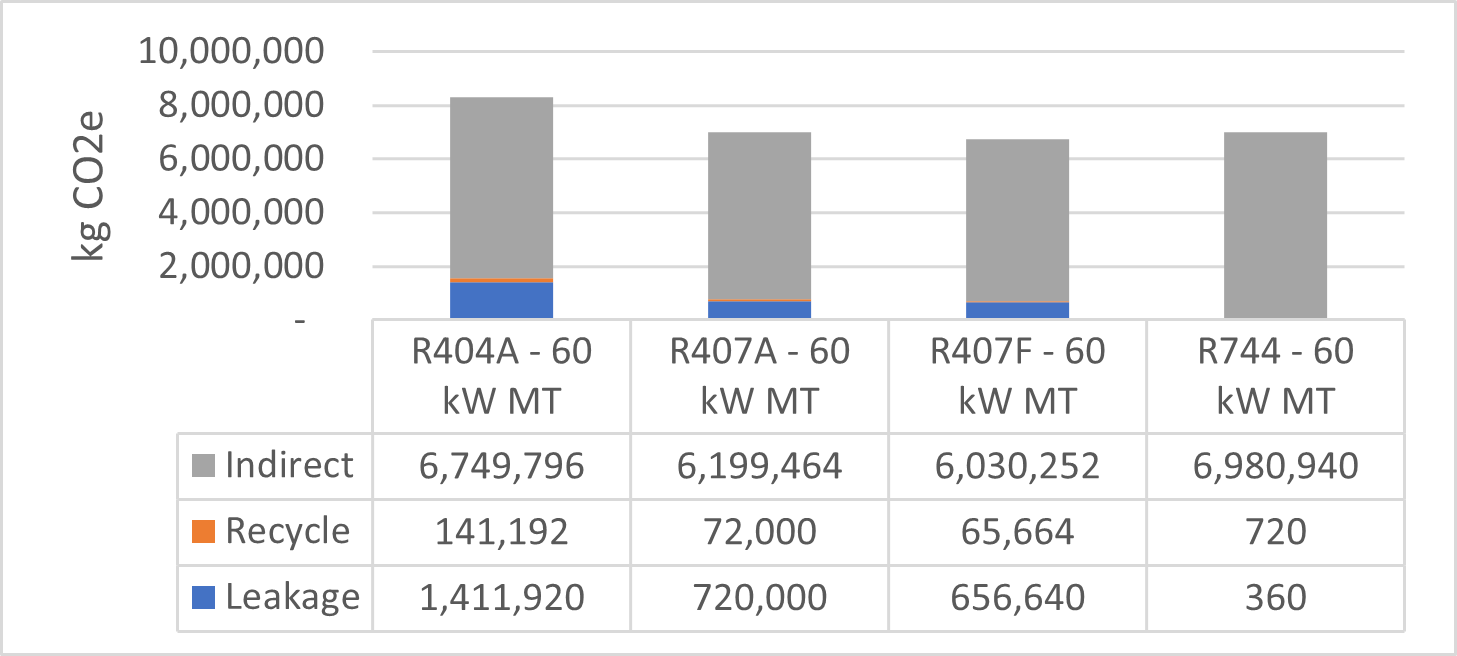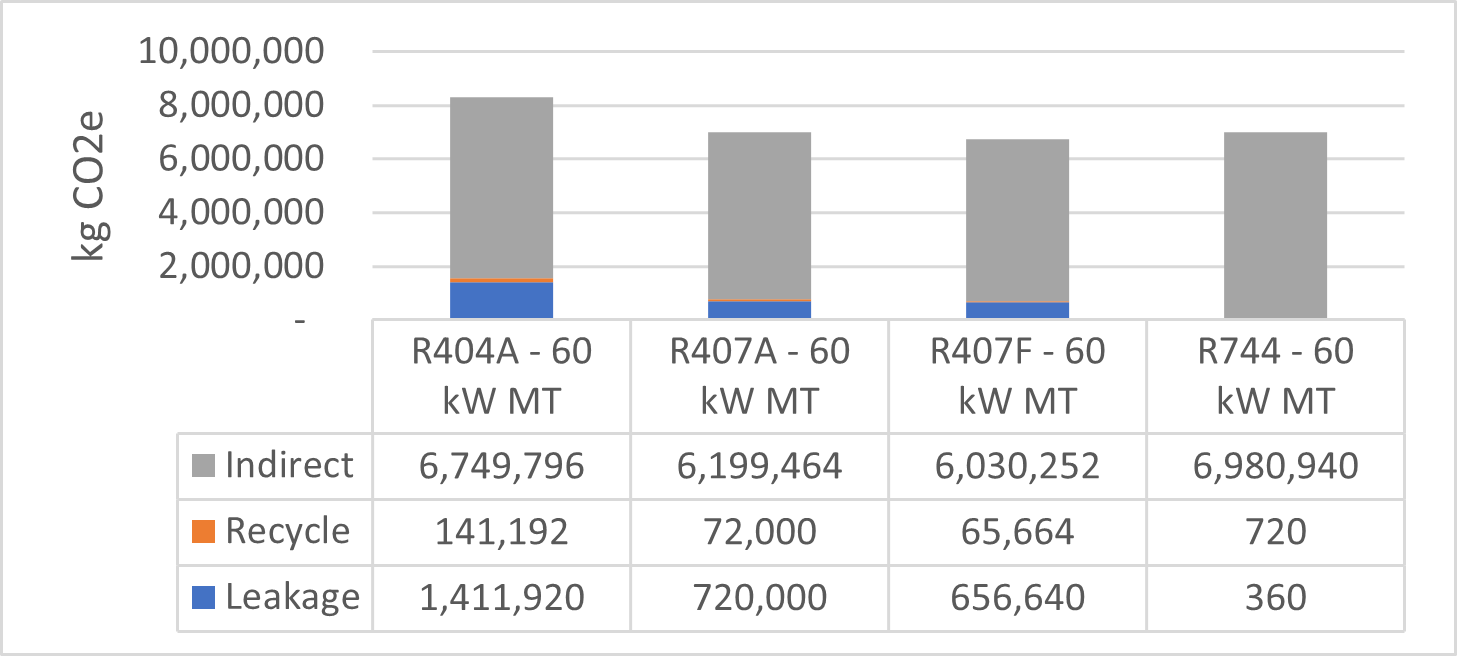20 April 2023
|

Aldi’s desire to improve refrigeration sustainability was the focus of a paper from Conor Eaton-Smith of K2 Engineering (Cooling) Ltd to the IOR Annual Conference. Here, he looks at some of the more notable and significant approaches covered by the paper.
2009-2011: opportunistic (non-elevated) heat recovery for all new stores
The recovery of waste heat had widespread application in Aldi during the late 2000s. Aldi shopfloors of the time were heated and ventilated using a single zone Constant Air Volume (CAV) system, utilising a ducted gas-fired air heater.
Meanwhile, the refrigeration in the store was provided by a single remote system, making it relatively straightforward to install a pre-heating coil in the supply air ductwork for energy recovery. As a result, this type of application was an effective solution with a simple bypass and no additional controls required.
With this type of system Aldi reduced the annual consumption of natural gas used for store heating by 55% annually.

Figure 1: Indicative heat recovery sketch
2009-2020: fully integrated refrigeration & heating systems
The first step to remove natural gas completely from its stores was with the installation of an integrated refrigeration and heating system in their Edgbaston store. This system consisted of a refrigeration pack and a single heat exchanger that would be used in working towards satisfying the store's heating demand as an air source heat pump unit.
The heat exchanger had two separate refrigeration circuits to provide heat rejection from the condensing side of the pack system, but also from the discharge side of the pack to generate heat if required (false load). In addition, the refrigeration pack was designed so that five out of six compressors could transition between two suction pressure groups, those for the refrigeration load in the store and those used by the external air heat exchanger during air source heat pump operation.
This integrated configuration allowed the system to efficiently meet two separate loads and optimise each Saturated Suction Temperature (SST) throughout the annual operational cycle. Furthermore, the plant requirement was reduced.
Additional energy savings result from a dynamic condensing temperature setpoint, which is optimised depending on ambient conditions or heating demand levels. As a consequence, the refrigeration coefficient of performance (CoP) is reduced compared to a refrigeration-only system because of the increase in power consumption, but when heat recovery generation is also taken into account, the total efficiency of the combined system is higher than two individual solutions.
As a result, the integrated heat recovery system reduced project Total Expenditure (TotEx), and along with the elimination of natural gas, reduced Aldi’s carbon footprint and meet local authority requirements for Low to Zero Carbon (LZC) energy generation.
2009-2017: Replacement of R404A with lower GWP alternatives
From 2009, Aldi adopted new heating strategies for its estate and also reduced its refrigerant emissions liability. This reduction was achieved by adopting alternative HFC refrigerants, which have a lower GWP. Table 1 highlights the main differences between the refrigerants historically used on the Aldi estate.
|
Refrigerant |
R404A (- 2015) |
R407A (2009 -) |
R407F (2014 -) |
R744 (2017 -) |
|
GWP (AR4 Values) |
3922 |
2107 |
1825 |
1 |
|
Nominal CoP |
2.23 |
2.32 |
2.34 |
1.86 |
|
Heat Recovery CoP |
2.46 |
2.51 |
2.51 |
2.64 |
Table 1: Comparison between Aldi refrigeration types
2016 onwards: transitioning to a carbon dioxide future
In 2016, Aldi made the decision to transition to natural refrigerants, with R744 providing remote mid temperature (MT) refrigeration having trialled systems from 2011. Evaluating this approach from a sustainability standpoint, a dynamic model was produced to compare different refrigerants as shown in the subsequent graphs

Graph 1: Lifetime equivalent CO2 emissions in ‘ideal’ conditions
Under relatively ‘ideal’ conditions for high and interim medium GWP refrigerants discounting heat recovery activities, the data in graph 1 demonstrates that R407F would offer a 3.3% reduction in lifetime emissions compared to R744. However, if more representative conditions are applied, including a 10% annual leakage rate, current carbon intensity figures from the National Grid, and load diversity factors, the carbon footprint changes significantly as shown in graph 2.

Graph 2: Lifetime equivalent CO2 emissions in representative conditions.
Considering all the different variables that retail refrigeration systems have to manage, R744 offers a significant reduction in carbon footprint and demonstrates a much lower relative impact through leakage compared to other refrigerants. Catastrophic loss of a refrigerant from a system is not always considered when comparing the direct impact refrigerants. Such losses have substantial impact to the environment, especially when involving high GWP refrigerants. A recent loss at a Scottish abattoir in Perth accounted for 87% of all HFCs released in Scotland during 2021 and potentially 0.87% of all of Scotland’s greenhouse gas emissions for 2021.
Furthermore, as the National Grid lowers carbon intensity further or additional local renewable energy generation is applied, the relative environmental gains from R744 will improve.

Graph 3: Trend of UK carbon intensity by fuel type (including transmission and distribution losses)
2020 onwards: closed fronted chilled display cabinets and other system refinements
In 2020 Aldi carried out a widespread trial of doored chilled display cabinets. The results of this adoption reduced refrigeration load significantly and allowed operation with higher evaporating temperatures to save energy. In addition, in one of the less obvious benefits to installing cabinet doors, Aldi was able to specify the use of parallel compression on the transcritical systems.
Historically in the UK, parallel compression for transcritical CO2 for refrigeration systems hasn’t offered an attractive return on investment, but now the case for parallel compression is different. For systems which adopt heat recovery – a larger proportion of time is spent in transcritical operation. Secondly, parallel compression allows for a significant reduction in compressor displacement. This has the welcome consequence of improving suction pressure control at low loads. For a given 60 kW system– the differences in system characteristics can be quite stark.
|
Flash gas Management for a 60 kW MT Pack |
Total compressor displacement (m3/h) |
Nominal Full Load Current (A) |
Nominal CoP at design conditions |
Minimum Capacity (kW) |
|
Flash gas Bypass |
31.5 |
76.7 |
1.59 |
20 |
|
Parallel Compression |
24.3 |
65.4 |
1.8 |
10 |
Table 2 Flash gas to parallel compression comparison
2022 onwards
Aldi continues to evaluate approaches to optimise total expenditure, with improvements to system efficiency and performance at the forefront of its considerations. In the last 15 years or more Aldi has gone through a notable transformation of the refrigeration technology and processes it uses. The results of this mean that it is well placed regarding sustainable practices now and into the future, while it continues to try and identify further improvements in sustainable refrigeration in a competitive marketplace.








